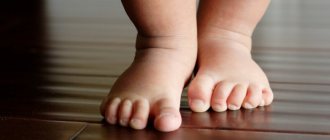Closer to the age of one, young mothers begin to wonder how to properly teach their baby to walk. Some children take their first steps at 10-12 months without much hassle, while others are just getting on their feet.
In our article you will find many simple and effective recommendations, after which your child will definitely learn to walk.
Of course, every parent dreams of their baby getting on his feet and walking as early as possible, but you shouldn’t rush him. The musculoskeletal system develops gradually, which is why kids must prepare for the upcoming loads.
First, the baby needs to master crawling, since it is movement on all fours that improves motor functions and strengthens muscles.
You should not get carried away with early “pacing” while watching other people’s children running, but it is necessary to prepare the child for upright walking.
Is there any need to rush?
Somehow, while “walking” through the Internet, I came across a message from a young mother claiming that her baby was trying to get up at almost 6 months. She is naturally delighted, but the doctor commenting on her words is not at all. He claims that the baby’s muscles are not yet strong, as is the musculoskeletal system. Consequently, the consequences of early walking can be disastrous: from incorrect foot placement to curvature of the lower leg.
The situation gets worse if the little one has certain health problems that his doctors and parents do not yet know about. True, this does not prevent the latter from trying with all their might to help the child learn to walk faster.
At the same time, such fears should not darken the mood if the baby himself tries to get up or take the first step ahead of time. In any case, Dr. Komarovsky is sure of this. According to him, a child gets up on his own if his body is already fully formed and ready for new achievements.
Do you also wear shoes at home?
No, of course: in the apartment you learn to walk barefoot, because it is not only convenient, but also strengthens the child.
However, if you are worried that your little one will slip while moving, put them in socks with rubberized soles, which are just as good at combating flat feet as the right shoes.
How to understand that your baby is ready
The age at which the little one takes his first step varies from person to person. According to orthopedists, this happens in most children at 1 year of age, but still it is not worth adjusting everyone to the standards. In the end, the indicator is influenced by genetics, temperament (sanguine and choleric people progress faster than melancholic and phlegmatic people), climate (southerners develop faster than northerners), and finally, illness and stress.
It is a well-known fact that children who grow up in a favorable environment without conflicts and quarrels from their parents take their first steps faster (sometimes even at 10 months) than those who live in constant swearing and screaming. By the way, stress can be caused not only by them, but also by frequent moves and strangers in the house.
Illness is another unfavorable factor. Even a common cold can delay the onset of the cherished hour, so if the baby has suffered it, there is no need to rush to help him walk yet.
Ideally, it is important to simply observe the child to understand that he is able to take his first steps. So, take a closer look. If you notice that the toddler:
- able to stand up while holding onto something;
- move along the support;
- travel from room to room on all fours;
- walk by the hand;
- conquer small horizons and climb onto low chairs...
So he is ready to walk. This is directly indicated by the fact that all this is done with great pleasure.
If you most often push him to these actions, but he himself does not receive joy from them, stop. You should not rush things, so as not to face unpleasant consequences. In the end, if time passes and the child does not express a desire to walk, it makes sense to show him to the doctor. Problems with the musculoskeletal system and the central nervous system can inhibit the ability to walk independently. Moreover, for the most part they can be corrected. All that is needed is timely diagnosis and treatment.
Taking the first steps
This period is especially important, since previously procedures were performed aimed at strengthening the child’s muscles, and now he must put into practice the knowledge already acquired.
Act as a companion
When the baby has enough strength to stand on his feet, he begins to walk around the apartment independently, using various pieces of furniture as support. At this point, it’s worth repeating the journey around the house with him again - the difference will be enormous, because the baby will cover most of the path without parental help.
But for a child to learn to walk very well, he needs constant support. To do this, one of the parents must hold his hand and go with him. Special push toys will come in handy: strollers complete with dolls, cars with handles.
Refusal of walkers
It is not recommended to develop the habit of using a walker in your child, as they complicate the process of taking the first steps. These devices narrow the baby's hips and pelvis, thereby delaying his progress in walking. In addition, walkers are quite dangerous: using this device, your child may well roll up to a hot radiator, gas stove, stairs or swimming pool.
Initially, it seems that walkers make the life of a young mother much easier, but this opinion is wrong, because every second she has to watch that nothing happens to the child.
The best option would be to use a stationary table for games.
Selection of interesting places to go
The long-awaited moment has arrived - the child has completely let go of all the objects supporting him and has learned to walk on his own. As a rule, this moment occurs between nine and thirteen months; by 14-15 months, children are already walking quite confidently. From this period on, it should not be surprising that while walking the baby finds various hobbies - kicking a ball, climbing or descending stairs. If you want to enjoy such moments, you should provide your baby with a path consisting of various toys or sports equipment.
It is forbidden to compare
Each child is individual. Some kids achieve their goals faster, others slower. One child learns to walk independently better, another worse. The time it takes to complete a particular goal directly depends on numerous factors, including weight and character. Even when the process is difficult, don't be upset or disappointed if your child doesn't learn to walk as quickly as other children.
You need to understand that all the indicated dates are approximate; there are no exact figures for when the child will learn to walk independently.
Choosing the right shoes
The purchase of the first shoes should be done in the evening, since then the foot is tense and increased in size. You need to help the child put on his shoes and give him the opportunity to stand in his shoes. It is recommended to make sure that the shoes are comfortable to wear and do not press anywhere.
Wearing purchased shoes, the child is recommended to walk around the room a little, after which the condition of the feet is checked: there should be no chafed areas or redness. If there is redness, then pay attention to large size shoes. Shoes should be purchased specifically for your current age (no ones for growth), with a solid high heel, the sole is plastic, and is equipped with an instep support, and has a convenient fastener.
A child can walk around the house barefoot - this is convenient and useful, as it strengthens the body. If there is a possibility that your baby will slip, then socks with rubberized soles are an excellent solution. They also prevent the formation of flat feet.
What to do to make it go faster
Do you want your baby to start at 11 months? Then start preparing him for this... from the cradle. Newborns benefit from massages and gymnastics. Already in a month, they need to be regularly placed on the tummy: this way the gases will be less annoying, and the muscles of the back and neck will become stronger.
At 3-4 months it’s time to learn to roll over. This will engage your back muscles and then help you take your first steps faster. By six months the baby begins to sit up. It happens that children come to this earlier, although doctors do not recommend this. From 6 months you can and should crawl, for a long time and with pleasure. The latter will happen if you constantly, as if by chance, leave your favorite toys out of reach. Then the kids follow them, and the skill is honed faster.
By the way, scientists discovered an interesting fact during the study. It turns out that children who actively crawled in infancy are easier to teach and incredibly successful in school, compared to those who immediately “went.” Perhaps this is indirectly explained by the fact that such kids are more inquisitive by nature.
What to do if the child does not walk?
If your child does not master the skill of walking, there is no need to worry (although you really want to do it!). Know that this will not affect the further development of the baby, and the age limits of the process range from 9 months to 1.2 years.
The later the baby begins to walk, the less will be the load on his spine. However, there are a number of reasons why the baby does not walk on time.
Diseases and rehabilitation period
If a child has recently suffered a serious illness or suffers from physical inactivity and allergies, it is completely normal that he will go a little later than other children.
Weakened vision
If a baby learning to walk keeps falling or moving around the house only with your vigilant support, he may have vision problems. To resolve this issue, consult an ophthalmologist.
Orthopedic problems
If your child is already 1.5 years old and is completely healthy, but his walking skills are not developing, you should seek help from an orthopedist or neurologist.
The reason may be the difficulty of the first steps, or the different lengths of the legs and even their curvature. The doctor can prescribe you a preventive or therapeutic massage, which will help your baby get back on his feet as quickly as possible and move towards new achievements!
After all, the world is so huge that it is not possible to “go around” it over many years of life. However, you should always strive for this - you must remember this and tell your child that many miracles and bright achievements await him ahead!
How to quickly teach walking
Parents often ask pediatricians how to teach their child to walk faster. They answer that it is necessary to use gymnastics. There are a number of exercises that will take no more than a few minutes a day, and the results will be excellent. Among them:
- Rack. Before learning to take the first steps, a child must learn to stand. Already at 9 months, you should squat him with his back to you, and then, holding him under your arms, carefully lift him, forcing him to straighten his legs. And so on several times. Hint: if you play rhythmic music at this time, things will be more fun.
- Fitball exercises. A round ball can serve well. Place your baby on it with its back facing you from the age of 6 months to develop coordination and teach it to maintain balance. You can also lay your baby on it, tummy or back, it doesn’t matter. The main thing is to do it constantly and make sure that the actions bring pleasure.
- Working with a stroller. I still watch with emotion the children holding on to their strollers and learning to take their first steps. Mom or dad is on the safe side. First, they hold the baby under the arms, then - by one arm, and later - they even allow him to move without support. Of course, the latter is already aerobatics, but it’s never too late to start moving towards it.
- Sticks. There are special sticks that can be purchased in the store. They are up to a meter in height and differ from ordinary ones in their polished or upholstered surface. They are given to the baby in both hands, and theirs are placed on top of his hands. So they walk together, as if on stilts, supporting the little walker.
- Rope. Its task is to make the little one move his legs, as if he were taking the first step. Stretch a rope in the middle of the room, using several paths between different pieces of furniture. Then they bring him to her, pushing him to step over, and so on several times. When he understands the essence, he can move on and complicate the tasks.
- Hoop training. This is an option for those who can stand, but cannot yet walk. The hoop is put on the baby in such a way that he grasps it with both hands. Then they move it, forcing the child to take steps with him.
There are other ways to learn to walk, without extraneous devices. Moreover, experts advise starting with them when answering the question of how to teach correctly.
- The first thing you need to learn is to walk while holding onto a support. This is possible only if the little one can stand. They place him on one side of the crib (it is preferable because of the twigs in a row), and they themselves stand on the other. Then the child is called to his place. Alternatively, you can lure him with a toy. The main thing is not to be overzealous if he starts crying, but to reschedule the lesson for a more favorable time.
- Now the task is to teach how to throw a support. Here it is important to first hold the little explorer by two arms, then you can throw one. Consistency is a guarantee of success. You cannot quit early, otherwise the child will not learn to feel self-confidence, without which it will be more difficult for him to walk.
- The first steps can be taken together with mom and dad. They sit opposite each other at a short distance, and place the baby in a kind of corridor. One turns him to face the other, holding him under the arms. Another calls, holding out his hands in a characteristic manner. Then the child tries to take a step when the first parent abandons him, and the second simply “creates a safety net” from his hands, but does not hold him.
At first, steps in the “from one to another” style will be barely noticeable, and the time without parental control will be minimal. But if you train daily, it will increase. At this stage, it is important to help, but not to overdo it: now one wrong move can ruin everything. And first of all, this concerns safety.
When do babies start walking?
In order to set foot on the “mortal” earth, the child has a long way to go: first master turning over and crawling, then sit and stand up independently, and only then take his first and memorable step. At the same time, many children walk along the support (cribs, strollers, gurneys) for some time, and only then break away from its “moral” support.
In any case, around the age of 11-12 months, most children cope well with short distances and “run” from dad to mom and back with solemn screams and squeaks. At one year old, babies become completely independent in this matter, and at 14 months they are already conquering sofas and ladders.










